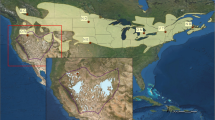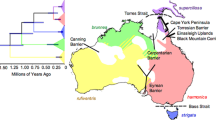Abstract
The breeding distribution of Painted Buntings (Passerina ciris) is comprised of two allopatric populations separated by a 550-km distributional gap in the southeastern United States. Curiously, the boundary between the two recognized P. ciris subspecies does not separate the two allopatric breeding populations but instead runs roughly through the center of the interior population. Genetic relationships among these subspecies, and the allopatric breeding populations of Painted Bunting, have not been assessed. Given the recent decline in overall abundance of this species, such an assessment is warranted. We sampled birds from 15 localities (138 individuals) and identified 35 distinct haplotypes, six belonging to the Atlantic Coast population and 26 to the interior population, with three shared by both populations. AMOVA results showed that a significantly greater portion of the total genetic variance is explained when grouping birds by the interior and Atlantic Coast populations rather than by subspecies. Furthermore, our data indicate that the Atlantic Coast and interior populations represent independently evolving taxa, with no measureable gene flow between them. Although recently diverged (26,000–115,000 years ago), these isolated bunting populations represent incipient species. For development of conservation strategies, we suggest that the Atlantic Coast and interior populations be recognized as separate management units.




Similar content being viewed by others
References
Able KP, Belthoff JR (1998) Rapid ‘evolution’ of migratory behaviour in the introduced house finch of eastern North America. Proc R Soc Lond B Biol Sci 265:2063–2071
Alderstam T, Hedenstrom A (1998) The development of bird migration theory. J Avian Biol 29:343–369
Althoff DM, Pellmyr O (2002) Examining genetic structure in a Bogus Yucca Moth: a sequential approach to phylogeography. Evolution 56:1632–1643
American Ornithologists’ Union (1957) Checklist of North American Birds. American Ornithologists’ Union, Washington DC
Avise JC (2000) Phylogeography, the history and formation of species. Harvard University Press, Cambridge
Avise JC (2004) Molecular markers, natural history and evolution. Sinauer Associates, Sunderland
Baker JM, Lopez-Medrano E, Savarro-Siguenza AG, Rojas-Soto OR, Omland KE (2003) Recent speciation in the Orchard Oriole group: divergence of Icterus spurius spurius and Icterus spurius fuertesi. Auk 120:848–859
Bandelt HJ, Forster P, Rohl A (1999) Median-joining networks for inferring intraspecific phylogenies. Mol Biol Evol 16:37–48
Bazin E, Glemin S, Galtier N (2006) Population size does not influence mitochondrial genetic diversity in animals. Science 312:570–572
Bensasson D, Zhang D, Hartl DL, Hewitt GM (2001) Mitochondrial pseudogenes: evolution’s misplaced witnesses. Trends Ecol Evol 16:314–321
Berthold P (1996) Control of bird migration. Chapman and Hall, London
Bowen BW, Bass AL et al (2005) Conservation implications of complex population structure: lessons from the loggerhead turtle (Caretta caretta). Mol Ecol 14:2389–2402
Cox J (1996) Painted bunting. University Press of Florida, Gainesville
Crandall KA, Templeton AR (1996) Applications of intraspecific phylogenies. In: Harvey PH, Brown AL, Smith JM, Nee S (eds) New uses for new phylogenies. Oxford University Press, Oxford, pp 81–99
Crandall KA, Templeton AR, Sing CF (1994) Intraspecific cladogram estimation: problems and solutions. In: Scotland RW, Siebert DJ, Williams DM (eds) Models in phylogeny reconstruction. Clarendon Press, Oxford, pp 273–297
Crandall KA, Bininda-Emonds O, Mace GM, Wayne RK (2000) Considering evolutionary processes in conservation biology. Trends Ecol Evol 15:290–295
DaCosta JM, Klicka J (2008) The Great American Interchange in birds: a phylogenetic perspective with the genus Trogon. Mol Ecol 17:1328–1343
DeSalle R, Amato G (2004) The expansion of conservation genetics. Nat Rev Genet 5:702–712
Edwards SV, Kingan SB, Calkins JD et al (2005) Speciation in birds: genes, geography and sexual selection. Proc Natl Acad Sci USA 102:6550–6557
Emerson BC, Paradis E, Thebaud C (2001) Revealing the demographic histories of species using DNA sequences. Trends Ecol Evol 16:707–716
Excoffier L, Laval G, Schneider S (2005) Arlequin v. 3.0: an integrated software package for population genetics data analysis. Evol Bioinform Online 1:47–50
Fu YX (1997) Statistical tests of neutrality of mutations against population growth, hitchhiking and background selection. Genetics 147:915–925
Funk DJ, Omland JE (2003) Species-level paraphyly and polyphyly: frequency, causes, and consequences, with insights from animal mitochondrial DNA. Ann Rev Ecol Syst 34:397–423
Gauthreaux SA (1996) Bird migration: methodologies and major research trajectories (1945–1995). Condor 98:442–453
Grant SW, Bowen BW (1998) Shallow population histories in deep evolutionary lineages of marine fishes: insights from sardines and anchovies and lessons of conservation. J Hered 89:415–426
Hackett S (1996) Molecular phylogenetics and biogeography of tanagers in the genus Ramphocelus (Aves). Mol Phylogenet Evol 5:368–382
Haig SM, Avise JC (1995) Avian conservation genetics. In: Avise JC, Hammrick JL (eds) Conservation genetics: case histories from nature. Chapman and Hall, New York, pp 160–189
Hedrick PW (2004) Recent developments in conservation genetics. Forest Ecol Manag 197:3–19
Hey J (2005) On the number of New World founders: a population genetic portrait of the peopling of the Americas. PLoS Biol 3:965–975
Hey J, Nielsen R (2004) Multilocus methods for estimating population sizes, migration rates and divergence time, with applications to the divergence of Drosophila pseudoobscura and D-persimilis. Genetics 167:747–760
Hey J, Nielson R (2007) Integration within the Felsenstein equation for improved Markov chain Monte Carlo methods in population genetics. Proc Natl Acad Sci 104:2785–2790
Howell SN, Webb J (1995) A guide to the birds of Mexico and Northern Central America. Oxford University Press, Oxford
Hunter WC, Pashley DN, Escano REF, Ronald EE (1993) Neotropical migratory landbird species and their habitats of special concern within the Southeast Region. In: Finch DM, Stangel PW (eds) Status and management of neotropical migratory birds. U.S. Department of Agriculture, Forest Service, Rocky Mountain Forest and Range Expansion Station, Fort Collins, pp 159–171
Inigo-Elias EE, Rosenberg KV, Wells JV (2002) The danger of beauty. Birdscope
Johnson JA, Dunn PO, Bouzat JL (2007) Effects of recent population bottlenecks on reconstructing the demographic history of prairie-chickens. Mol Ecol 16:2203–2222
Klicka J, Zink RM, Barlow WB, McGillivray WB, Doyle TJ (1999) Evidence supporting the recent origin and species status of the Timberline Sparrow. Condor 101:577–588
Klicka J, Fry AJ, Zink RM, Thompson CW (2001) A cytochrome-b perspective on Passerina bunting relationships. Auk 118:611–623
Knowles LL, Maddison WP (2002) Statistical phylogeography. Mol Ecol 11:2623–2635
Kocher TD (1991) Sequence evolution of mitochondrial DNA in human and chimpanzees: Control region and protein coding region. In: Osawa S, Honjo T (eds) Evolution of life: fossils, molecules, and culture. Springer, Japan, pp 391–413
Land HC (1970) Birds of Guatemala. Livingstone, Wynnewood
Lande R, Engen S, Saether BE (2003) Stochastic population dynamics in ecology and conservation. Oxford University Press, Oxford
Lowther PE, Lanyon SM, Thompson CW (1999) Painted Bunting (Passerina ciris). In: Poole A, Gill F (eds) The Birds of North America, No. 398. The Birds of North America, Inc., Philadelphia
Maddison D, Maddison W (2000) MacClade: analysis of phylogeny and character evolution. Sinauer Associates, Sunderland
Manel S, Gaggiotti OE, Waples RS (2005) Assignment methods: matching biological questions with appropriate techniques. Trends Ecol Evol 20:136–142
Mantel N (1967) The detection of disease clustering and a generalized regression approach. Cancer Res 27:209–220
Mearns EA (1911) Description of a new subspecies of the Painted Bunting from the interior of Texas. Proc Biol Soc Wash 24:217–218
Moritz C (1994) Defining ‘evolutionary significant units’ for conservation. Trends Ecol Evol 9:373–375
Nielsen R, Wakeley J (2001) Distinguishing migration from isolation: a markov chain Monte Carlo approach. Genetics 158:885–896
Omland KE, Baker JM, Peters JL (2006) Genetic signatures of intermediate divergence: population history of old and new world Holarctic ravens (Corvus corax). Mol Ecol 15:795–808
Pearse DE, Crandall KA (2004) Beyond FST analysis of population genetic data for conservation. Conserv Genet 5:585–602
Perez-Eman JL (2005) Molecular phylogenetics and biogeography of the Neotropical Redstarts (Myioborus; Aves Parulinae. Mol Phylogenet Evol 37:511–528
Posada D, Crandall KA (2001) Intraspecific gene genealogies: trees grafting into networks. Trends Ecol Evol 16:37–45
Raffaele H, Wiley J et al (1998) A guide to the birds of the West Indies. Princeton University Press, Princeton
Ramos-Onsins SE, Rozas J (2002) Statistical properties of new neutrality tests against population growth. Mol Biol Evol 19:2092–2100
Rich TD, Beardmore CJ, Berlanga H et al (2004) Partners in flight North American landbird conservation plan. Cornell Lab of Ornithology, Ithaca
Robertson WB, Woolfenden GE (1992) Florida bird species: an annotated list. Florida Ornithological Society Special Publication 6
Rogers AR, Harpending H (1992) Population growth makes waves in the distribution of pairwise genetic differences. Mol Biol Evol 9:552–569
Rozas J, Sanchez-DelBarrio JC, Messeguer X, Rozas R (2003) DnaSP, DNA polymorphism analyses by the coalescent and other methods. Bioinformatics 19:2496–2497
Rubinoff D, Splerling FAH (2004) Mitochondrial DNA sequence, morphology and ecology yield contrasting conservation implications for two threatened Buckmoths (Hemileuca: Saturniidae). Biol Conserv 118:341–351
Sauer JR, Hines G, Gough G, Thomas I, Peterjohn BG (1997) The North American breeding bird survey results and analysis. Patuxent Wildlife Research Center, Laurel
Schneider S, Excoffier L (1999) Estimation of past demographic parameters from the distribution of pairwise differences when the mutation rates vary among sites: application to human mitochondrial DNA. Genetics 152:1079–1089
Slatkin M, Hudson RR (1991) Pairwise comparisons of mitochondrial DNA sequences in stable and exponentially growing populations. Genetics 129:555–562
Smith TB, Wayne RK (1996) Molecular genetic approaches in conservation. Oxford University Press, New York
Smith TB, Clegg SM, Kimura M, Ruegg KC, Mila B, Lovette IJ (2004) Molecular genetic approaches to linking breeding and overwintering areas in five Neotropical migrant Passerines. In: Greenberg R, Marra PP (eds) Birds of two worlds: the ecology and evolution of migration. Johns Hopkins University Press, Baltimore, pp 224–234
Smouse PE (1998) To tree or not to tree. Mol Ecol 7:399–412
Smouse PE, Long JC, Sokal RR (1986) Multiple-regression and correlation extensions of the mantel test of matrix correspondence. Syst Zool 35:627–632
Spellman GM, Riddle B, Klicka J (2007) Phylogeography of the Mountain Chickadee (Poecile gambeli): diversification, introgression, and expansion in response to Quaternary climate change. Mol Ecol 16:1055–1068
Storer RW (1951) Variation in the Painted Bunting (Passerina ciris), with special reference to wintering populations. Occas Pap Mus Zool 532:1–11
Sykes PWJ, Holzman S (2005) Current range of the eastern population of Painted Bunting (Passerina ciris) Part 1: Breeding. North Am Birds 29:4–17
Sykes PWJ, Holzman S, Inigo-Elias EE (2007) Current range of the eastern population of Painted Bunting (Passerina ciris) Part II: Winter range. North American Birds 61:378–406
Tajima F (1989) The effect of change in population-size on DNA polymorphism. Genetics 123:597–601
Thompson CW (1991a) Is the Painted Bunting actually 2 species—problems determining species limits between allopatric populations. Condor 93:987–1000
Thompson CW (1991b) The sequence of molts and plumages in Painted Buntings and implications for theories of delayed plumage maturation. Condor 93:209–235
Wakeley J, Hey J (1997) Estimating ancestral population parameters. Genetics 145:847–855
Webster MS, Marra PP, Haig SM, Bensch S, Holmes RT (2002) Links between worlds: unraveling migratory connectivity. Trends Ecol Evol 17:76–83
Zink RM, Barrowclough GF (2008) Mitochondrial DNA under siege in avian phylogeography. Mol Ecol 17:2107–2121
Zink RM, Pavlova A, Drovetski S, Rohwer S (2008) Mitochondrial phylogeographies of five widespread Eurasian bird species. J Ornithol 149:399–413
Acknowledgments
Financial support for this project was provided by the Barrick Museum of Natural History and the Graduate & Professional Student Association of the University of Nevada, Las Vegas. We are grateful to Jeremy Batten and Kyle Kacy for field assistance. The authors thank Mercedes Foster, Stacy Mantooth, and Brian Smith for comments on an earlier version of this manuscript.
Author information
Authors and Affiliations
Corresponding author
Rights and permissions
About this article
Cite this article
Herr, C.A., Sykes, P.W. & Klicka, J. Phylogeography of a vanishing North American songbird: the Painted Bunting (Passerina ciris). Conserv Genet 12, 1395–1410 (2011). https://doi.org/10.1007/s10592-011-0237-6
Received:
Accepted:
Published:
Issue Date:
DOI: https://doi.org/10.1007/s10592-011-0237-6




